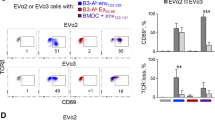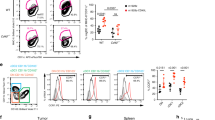Abstract
The outcome of antigen recognition by naive CD8+ cytotoxic T lymphocytes (CTLs) in the periphery is orchestrated by CD4+ T-helper cells, and can either lead to priming or tolerization. The presence of T-helper cells favors the induction of CTL immunity, whereas the absence of T-helper cells can result in CTL tolerance. The action of T helper cells in CTL priming is mediated by CD40–CD40 ligand interactions. We demonstrate here that triggering of CD40 in vivo can considerably enhance the efficacy of peptide-based anti-tumor vaccines. The combination of a tolerogenic peptide vaccine containing a minimal essential CTL epitope with an activating antibody against CD40 converts tolerization into strong CTL priming. Moreover, CD40 ligation can provide an already protective tumor-specific peptide vaccine with the capacity to induce therapeutic CTL immunity in tumor-bearing mice. These findings indicate that the CD40–CD40 ligand pair can act as a 'switch', determining whether naive peripheral CTLs are primed or tolerized, and support the clinical use of CD40-stimulating agents as components of anti-cancer vaccines.
This is a preview of subscription content, access via your institution
Access options
Subscribe to this journal
Receive 12 print issues and online access
$209.00 per year
only $17.42 per issue
Buy this article
- Purchase on Springer Link
- Instant access to full article PDF
Prices may be subject to local taxes which are calculated during checkout







Similar content being viewed by others
References
Aichele, P., Brduscha-Riem, K., Zinkernagel, R.M., Hengartner, H. & Pircher, H. T cell priming versus T cell tolerance induced by synthetic peptides. J. Exp. Med. 182, 261–266 (1995).
Feltkamp, M.C. et al. Vaccination with cytotoxic T lymphocyte epitope-containing peptide protects against a tumor induced by human papillomavirus type 16-transformed cells. Eur. J. Immunol. 23, 2242– 2249 (1993).
Aichele, P. et al. Peptide-induced T-cell tolerance to prevent autoimmune diabetes in a transgenic mouse model. Proc. Natl. Acad. Sci. USA 91, 444–448 (1994).
Aichele, P. et al. Peptide antigen treatment of naive and virus-immune mice: antigen- specific tolerance versus immunopathology. Immunity 6, 519–529 (1997).
Toes, R.E., Blom, R.J., Offringa, R., Kast, W.M. & Melief, C.J. Enhanced tumor outgrowth after peptide vaccination. Functional deletion of tumor-specific CTL induced by peptide vaccination can lead to the inability to reject tumors. J. Immunol. 156, 3911–3918 (1996).
Toes, R.E.M., Offringa, R., Blom, R.J.J., Melief, C.J.M. & Kast, W.M. Peptide vaccination can lead to enhanced tumor growth through specific T cell tolerance induction. Proc. Natl. Acad. Sci. USA 93, 7855– 7860 (1996).
Toes, R.E. et al. Enhancement of tumor outgrowth through CTL tolerization after peptide vaccination is avoided by peptide presentation on dendritic cells. J. Immunol. 160, 4449– 4456 (1998).
Guerder, S. & Matzinger, P. A fail-safe mechanism for maintaining self-tolerance. J. Exp. Med. 176, 553– 564 (1992).
Kurts, C. et al. CD4+ T cell help impairs CD8+ T cell deletion induced by cross- presentation of self-antigens and favors autoimmunity. J. Exp. Med. 186, 2057–2062 (1997).
Schoenberger, S.P., Toes, R.E.M., Vandervoort, E.I.H., Offringa, R. & Melief, C.J.M. T-cell help for cytotoxic T-lymphocytes is mediated by CD40-CD40l interactions. Nature 393, 480–483 (1998).
Bennett, S.R.M. et al. Help for cytotoxic-T-cell responses is mediated by CD40 signaling. Nature 393, 478–480 (1998).
Cella, M. et al. Ligation of CD40 on dendritic cells triggers production of high levels of interleukin-12 and enhances T cell stimulatory capacity: T-T help via APC activation. J. Exp. Med. 184, 747–752 (1996).
Ridge, J.P., Dirosa, F. & Matzinger, P. A conditioned dendritic cell can be a temporal bridge between a CD4(+) T-helper and a T-killer cell. Nature 393, 474–478 (1998).
Ding, L. & Shevach, E.M. Activated B cells express CD28/B7-independent costimulatory activity. J. Immunol. 157, 1389–1396 (1996).
Bennett, S.R., Carbone, F.R., Toy, T., Miller, J.F. & Heath, W.R. B cells directly tolerize CD8(+) T cells. J. Exp. Med. 188, 1977–1983 (1998).
Feltkamp, M.C. et al. Cytotoxic T lymphocytes raised against a subdominant epitope offered as a synthetic peptide eradicate human papillomavirus type 16-induced tumors. Eur. J. Immunol. 25, 2638– 2642 (1995).
Mayordomo, J.I. et al. Bone marrow-derived dendritic cells pulsed with synthetic tumour peptides elicit protective and therapeutic antitumour immunity. Nature Med. 1, 1297–1302 (1995).
Parker, D.C. et al. Survival of mouse pancreatic islet allografts in recipients treated with allogeneic small lymphocytes and antibody to CD40 ligand. Proc. Natl. Acad. Sci. USA 92, 9560– 9564 (1995).
Yang, Y. et al. Transient subversion of CD40 ligand function diminishes immune responses to adenovirus vectors in mouse liver and lung tissues. J. Virol. 70, 6370–6377 (1996).
Rees, M.A., Rosenberg, A.S., Munitz, T.I. & Singer, A. In vivo induction of antigen-specific transplantation tolerance to Qa1a by exposure to alloantigen in the absence of T-cell help. Proc. Natl. Acad. Sci. USA 87, 2765–2769 (1990).
Anderton, S.M., van der Zee, R. & Goodacre, J.A. Inflammation activates self hsp60-specific T cells. Eur. J. Immunol. 23, 33– 38 (1993).
Howell, C.D. & Yoder, T.D. Murine experimental autoimmune hepatitis: nonspecific inflammation due to adjuvant oil. Clin. Immunol. Immunopathol. 72, 76–82 (1994).
Fayolle, C. et al. Induction of cytotoxic T-cell response by optimal-length peptides does not require CD4+ T-cell help. Immunology 89, 41–45 (1996).
Ehl, S. et al. Viral and bacterial infections interfere with peripheral tolerance induction and activate CD8+ T cells to cause immunopathology. J. Exp. Med. 187, 763–774 (1998).
Dullforce, P., Sutton, D.C. & Heath, A.W. Enhancement of T cell-independent immune responses in vivo by CD40 antibodies. Nature Med. 4, 88–91 (1998).
Kawabe, T. et al. The immune responses in CD40-deficient mice: impaired immunoglobulin class switching and germinal center formation. Immunity 1, 167–178 (1994).
Rolink, A., Melchers, F. & Andersson, J. The SCID but not the RAG-2 gene product is required for S mu-S epsilon heavy chain class switching. Immunity 5, 319–330 (1996).
Kitamura, D., Roes, J., Kuhn, R. & Rajewsky, K. A B cell-deficient mouse by targeted disruption of the membrane exon of the immunoglobulin mu chain gene. Nature 350, 423– 426 (1991).
Schoenberger, S.P. et al. Efficient direct priming of tumor-specific cytotoxic T lymphocyte in vivo by an engineered APC. Cancer Res. 58, 3094–3100 (1998).
Lin, K.Y. et al. Treatment of established tumors with a novel vaccine that enhances major histocompatibility class II presentation of tumor antigen. Cancer Res. 56, 21–26 (1996).
Altman, J.D. et al. Phenotypic analysis of antigen-specific T lymphocytes. Science 274, 94–96 (1996).
Haanen, J.B. et al. Systemic T cell expansion during localized viral infection. Eur. J. Immunol. 29, 1168– 1174 (1999).
Acknowledgements
We thank F. Claas for critically reading our manuscript and A.H. Zwinderman for statistical analysis. The research of R.E.M.T. was made possible by a fellowship of the Royal Academy of Arts and Sciences. This work was supported by the Dutch Cancer Foundation (grants RUL 97-1449 and RUL-97-1450). S.P.S is supported by a grant from the American Cancer Society.
Author information
Authors and Affiliations
Corresponding author
Rights and permissions
About this article
Cite this article
Diehl, L., den Boer, A., Schoenberger, S. et al. CD40 activation in vivo overcomes peptide-induced peripheral cytotoxic T-lymphocyte tolerance and augments anti-tumor vaccine efficacy. Nat Med 5, 774–779 (1999). https://doi.org/10.1038/10495
Received:
Accepted:
Issue Date:
DOI: https://doi.org/10.1038/10495
This article is cited by
-
Perspective view of allogeneic IgG tumor immunotherapy
Cancer Cell International (2024)
-
Cell targeting and immunostimulatory properties of a novel Fcγ-receptor-independent agonistic anti-CD40 antibody in rhesus macaques
Cellular and Molecular Life Sciences (2023)
-
CD40 stimulation as a molecular adjuvant for cancer vaccines and other immunotherapies
Cellular & Molecular Immunology (2022)
-
C4b-binding protein α-chain enhances antitumor immunity by facilitating the accumulation of tumor-infiltrating lymphocytes in the tumor microenvironment in pancreatic cancer
Journal of Experimental & Clinical Cancer Research (2021)
-
APX005M, a CD40 agonist antibody with unique epitope specificity and Fc receptor binding profile for optimal therapeutic application
Cancer Immunology, Immunotherapy (2021)



